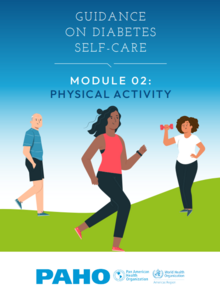Regular physical activity is a key protective factor in preventing and controlling noncommunicable diseases such as diabetes. It also promotes mental health by preventing cognitive decline, depression, and anxiety, and contributes to overall well-being. Finally, because it increases insulin sensitivity, it helps lower blood glucose levels and reduce conditions that aggravate diabetes and its complications. Because it also strengthens the heart, improves circulation in the legs, and lowers blood pressure and cholesterol levels, physical activity is also essential to prevent the main complications of diabetes, which are retinopathy, chronic kidney disease, and foot injuries (diabetic foot). Another benefit is the possibility of maintaining a healthy weight. For that reason, if a person is overweight or obese, physical activity, along with a healthy diet, can help reduce weight and belly fat (abdominal girth). This module describes a key element in diabetes care, which is physical activity. It is aimed at people living with the disease, their families, and caregivers. Its purpose is to contribute to self-care by providing some basic recommendations for incorporating physical activity as part of the daily life of people with diabetes. These recommendations do not replace the indications of the physician or healthcare team, but they can help to improve diabetes self-management and also to prevent its complications. |

